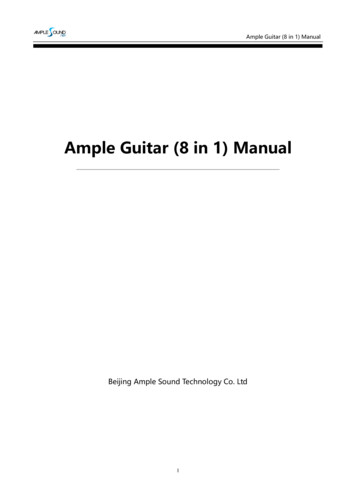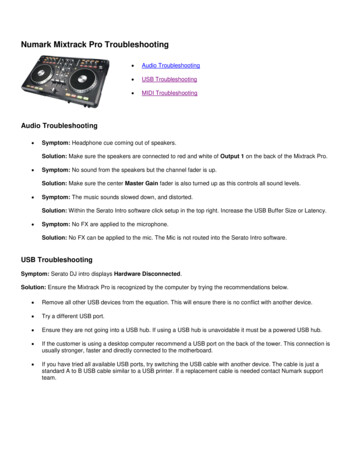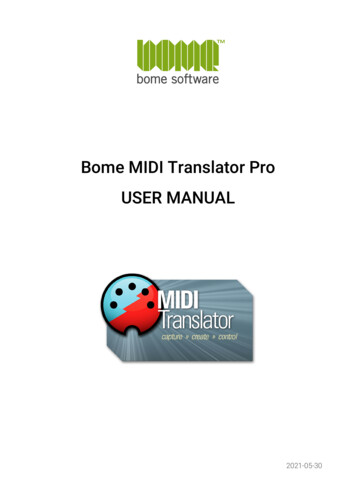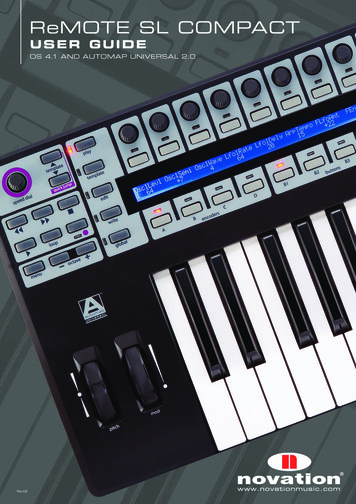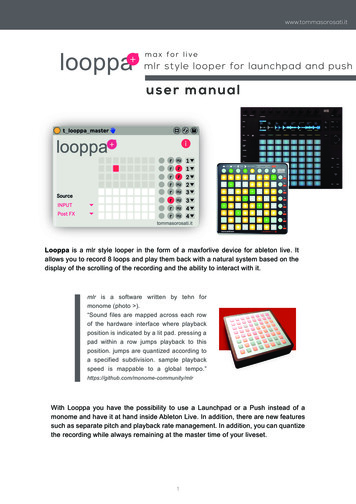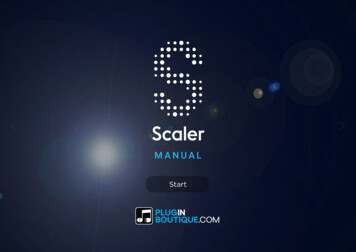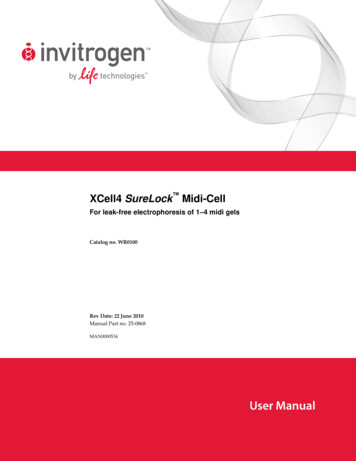
Transcription
XCell4 SureLock Midi-CellFor leak-free electrophoresis of 1–4 midi gelsCatalog no. WR0100Rev Date: 22 June 2010Manual Part no. 25-0868MAN0000534User Manual
ii
Table of ContentsTable of Contents. iiiSafety Information. ivSicherheits-Anweisungen. viInstructions de securite. viiExperienced Users Procedure.viiiContents.xIntroduction . 1Product Description .1Description of Parts.2Experimental Overview.4Methods . 5General Guidelines for Preparing Samples and Buffers .5Assembling the XCell4 SureLock Midi-Cell .7Performing Electrophoresis .13Disassembling the XCell4 SureLock Midi-Cell.14Troubleshooting.16Appendix. 17Product Specifications.17Accessory Products .18Technical Support.19Purchaser Notification .20iii
Safety InformationSafetyDuring operation, use the XCell4 SureLock Midi-Cell with an external DCpower supply designed specifically for electrophoresis applications. This powersupply must be isolated from ground so that the DC output is floating and mustbe equipped with No Load or Open Circuit protection. The maximum electricaloperating parameters for the XCell4 SureLock Midi-Cell are:Maximum Voltage Limit:600 Volts DCMaximum Power Limit:200 WattsOperating Temperature:4–40 C The XCell4 SureLock Midi-Cell lid is designed such that if the lid is removed,the electrical connection to the Midi-Cell will be broken. Do not attempt to usethe cell without the cell lid.The XCell4 SureLock Midi-Cell is designed to meet EN61010-1 SafetyStandards. This product is safe to use when operated in accordance with thisinstruction manual. If this Midi-Cell is used or modified in a manner notspecified in this manual, then protection afforded by the Midi-Cell will beimpaired. Alteration of this Midi-Cell will: Void the warranty. Void the EN61010-1 safety standard certification. Create a potential safety hazard.Invitrogen is not responsible for any injury or damage caused by use of thisMidi-Cell when operated for purposes which it is not intended. All repairs andservice should be performed by Invitrogen.The XCell4 SureLock Midi-Cell is classified as Class II for protection againstelectrical shock.Continued on next pageiv
Safety Information, ContinuedImportantThe XCell4 SureLock Midi-Cell is manufactured in the USA from domesticand International components.To ensure safe, reliable operation, always operate the XCell4 SureLock MidiCell according to instructions provided in this manual. Wear protective glovesand safety glasses when working in a laboratory environment.Invitrogen is not responsible for injuries or damages caused by improper use.InformationalSymbolsThe symbols used on the XCell4 SureLock Midi-Cell are explained below:Used on the XCell4 SureLock Midi-Cell to indicate an area where a potentialshock hazard may exist.Used on the XCell4 SureLock Midi-Cell to indicate a warning. The operator’smanual should be consulted to avoid possible personal injury or instrumentdamage.WEEE (Waste Electrical and Electronic Equipment) symbol indicates that thisproduct should not be disposed of in unsorted municipal waste. Follow localmunicipal waste ordinances for proper disposal provisions to reduce theenvironmental impact of WEEE. Visit www.invitrogen.com/weee forcollection and recycling options.v
Sicherheits-AnweisungenSicherheitsAnweisungenDie XCell4 Elektrophorese-Zelle muss mit einer geerdeten GleichstromSpannungsquelle betrieben werden, die speziell für die Elektrophoreseentwickelt wurde. Um eine Gefährdung des Benutzers durch Stromschlag zuminimieren, muss das g produzieren, die vom Erdleiter elektrisch getrenntist, und es muss mit einer Schutzschaltung gegen Fehlströme (FI Schutzschalter) ausgestattet sein. Desweiteren sollten folgendeLaufbedingungen für die XCell4 Elektrophorese-Zelle eingehalten werden:Maximale Spannung:600 Volts DCMaximale Leistung:200 WattsTemperatur:4-40 CBeim Entfernen des Kammerdeckels der XCell4 Electrophorese-Zelle wird derStromflub unterbrochen. Die Benutzung der Zelle ohne Deckel ist verboten.Die XCell4 Elektrophorese-Zelle entspricht den Sicherheits-Richtlinien EN61010-1. Es besteht keinerlei Gefährdung für den Benutzer, wenn dieRichtlinien der Gebrauchsanweisung eingehalten werden. Wird dieElektophorese-Zelle in einer Art und Weise benutzt bzw. modifiziert, die nichtin der Gebrauchsanleitung beschrieben ist, werden die Sicherheitvorkehrungenzum Schutz des Betreibers beeinträchtigt. Bei unsachgemässer Handhabungentfallen alle Garantieansprüche und Sicherheitszulassungen (EN61010-1).Invitrogen haftet nicht für Verletzungen oder Schäden jeglicher Art, wenn dieElektrophorese-Zelle für Anwendungen eingesetzt wird, für die die Zelle nichtentwickelt wurde. Alle Reparaturen und Wartungen müssen von Invitrogenoder einem von Invitrogen authorisierten Händler vorgenommen werden.Das Gehäuse der XCell4 Elektrophorese-Zelle besteht aus Kunststoff undenthält keine leitenden Teile.SymbolerklÄrungWeist auf eine Zone hin, wo Gefährdung durch Stromschlag besteht.Lesen Sie die Bedienungsanleitung, um Verletzungen oder Beschädigung desGerätes zu vermeiden.WEEEvi
Instructions de securiteInstructions desecuriteLa XCell4 SureLock Midi-Cell doit être utiliser uniquement avec unealimentation en courant contimu DC externe et spécialement conçue pour enusage avec un systeme électrophorése. Cette alimentation doit être isolee etsans contact avec la terre et doit etre equipee aven un systeme de protection encas de Non Charge ou Circuit ouvert.Le domaine d'utilisation de la XCell4 SureLock Midi-Cell est limité par lesparamétres de fonctionnement suivants:Tension maximum:600 Volts DCPuissance maximum:200 WattsTempèrature:4-40 C La XCell4 SureLock Midi-Cell est conçue de façon á ce que lorsque lecouvercle de la cuve est ouvert, la connection électrique est interrompue. Il nefaut en aucun cas essayer de faire fonctionner la cuve sans le couvercle.La XCell4 SureLock Midi-Cell satisfait aux normes de sécurité EN 61010-1. Lasécurité est assurée dans tous les cas d'une utilisation conforme au manueld'utilisation. Dans le cas ou la cellule serait modifiée ou utilisée de manière nonspécifiée dans le manuel d'utilisation, la sécurité de l'utilisateur pourrait êtreremise en cause. En cas d'utilisation non conforme toutes les garanties sinsi queles certifications de conformité aux normes de sécurité sont abrogeès.La responsabilité de Invitrogen ne péut être mise en cause en cas d' accident etdommages causés par une utilisation non conforme de la XCell4 SureLock Midi-Cell. Toute intervention de service ou de réparation doit être unquementeffectuée par Invitrogen ou par un agent agrée de Invitrogen.La XCell4 SureLock Midi-Cell est classifié par rapport à la norme d'isolationélectrique en classe II.Signification des pictogrammesSur le XCell4 SureLock Midi-Cell, signale les zones où un risque de chocélectrique peut exister.Sur XCell4 SureLock Midi-Cell, signale un risque potentiel pour l’utilisateurou pour l’equipement. Veuillez consulter le mode d’emploi.WEEEvii
Experienced Users ProcedureA brief experienced users procedure for performing electrophoresis with theXCell4 SureLock Midi-Cell is described below. If you are a first time user ofthe XCell4 SureLock Midi-Cell, refer to the detailed protocols in this manual.IntroductionStepProcedurePrepare Sampleand BufferPrepare protein sample at the appropriate concentration using the NuPAGE LDSSample Buffer or Tris-Glycine SDS Sample Buffer for denaturing SDS-PAGE andusing the Tris-Glycine Native Sample Buffer for native PAGE (for use withNuPAGE Midi Tris-Acetate Midi and Tris-Glycine Midi Gels only).Prepare the following 1X Running Buffer (see page 5 for the amount of bufferneeded based on the number of gels used).1X NuPAGE MES SDS Running Buffer toNuPAGE Bis-Tris Midi Gelsresolve small proteins1X NuPAGE MOPS SDS Running Buffer toresolve mid-size proteins 1X NuPAGE Tris-Acetate SDS RunningNuPAGE Tris-Acetate Midi GelsBuffer to resolve large proteins1X Tris-Glycine Native Running Buffer toperform native gel electrophoresisTris-Glycine Midi Gels1X Tris-Glycine SDS Running Buffer fordenaturing SDS-PAGE1X Tris-Glycine Native Running Buffer fornative gel electrophoresis1. Remove the gel cassette from the pouch and rinse with deionized water.Prepare GelCassetteAssembly with 4Gels2. Peel off the tape covering the slot on the back of the gel cassette and pull thecomb out of the cassette. Rinse the wells with 1X running buffer and fill thesample wells with running buffer.Instructions for assembling four gels are described below. For assembling less thanfour gels, see page 9.1.Insert the XCell4 SureLock Assembly in its unlocked position into the center ofthe Midi-Cell base. The XCell4 SureLock Assembly slides down over theprotrusion in the Midi-Cell base.2.Place one cassette on each side of both Buffer Cores.3.While holding the assembly together with your hands, insert the Buffer Coreswith the gel cassettes into the Lower Buffer Chamber such that the negativeelectrode fits into the opening in the gold plate on the Lower Buffer Chamber.Always hold the cassette assembly by its edges.4.Lock the XCell4 SureLock Assembly by moving the tension lever to the lockedposition (indicated on the XCell4 SureLock Assembly). This will squeeze the gelsand Buffer Cores together, creating leak free seals.Continued on next pageviii
Experienced Users Procedure, ContinuedStepProcedureAdd Buffer andLoad Samples1.2.3.4.5.Disassembly1.2.3.4.Fill each of the Upper Buffer Chambers with 175 mL of the appropriate 1X runningbuffer. For running NuPAGE Midi Gels under reducing conditions, use 1XRunning Buffer with 435 μl NuPAGE Antioxidant in each of the Upper BufferChambers. Ensure that the Upper Buffer Chambers are not leaking.Load the appropriate volume of the protein sample and molecular weight markersin the wells.Add 700 mL 1X running buffer (for 4 gels) to the Lower Buffer Chamber (anode) bypouring into the center of the Midi-Cell (over the XCell4 SureLock Assembly). Fillto the fill line marked on the Midi-Cell.Place the lid on the assembled XCell4 SureLock Midi-Cell. The lid firmly seats ifthe (-) and ( ) electrodes are properly aligned.With the power off, connect the electrode cords to power supply. Turn on thepower and perform electrophoresis as follows.Gel TypeNuPAGE Bis-Tris SDS-PAGE withMES Running BufferVoltage200 V ConstantRun Time40 minutesNuPAGE Bis-Tris SDS-PAGE withMOPS Running Buffer200 V Constant55 minutesNuPAGE Tris-Acetate SDS-PAGE(denaturing, reducing)150 V Constant70 minutesNuPAGE Tris-Acetate SDS-PAGE(native)150 V Constant2-3 hoursTris-Glycine with SDS Running Buffer(denaturing, reducing)125 V Constant105 minutesTris-Glycine with Tris-Glycine NativeRunning Buffer (native electrophoresis)125 V Constant1–12 hoursRemove the lid. Discard the buffer.Unlock the XCell SureLock Assembly by moving the tension lever to the unlockedposition (indicated on the XCell SureLock Assembly).Remove the Buffer Cores with gel cassettes from the Lower Buffer Chamber whileholding the cassettes against the cores.Remove the gel cassettes from Buffer Cores and carefully insert the Gel Knife’s(included with the Midi-Cell) beveled edge into the narrow gap between the twoplates of the cassette. Caution: Use caution while inserting the Gel Knife between the twoplates to avoid excessive pressure towards the gel.5.6.7.Push up and down gently on the knife’s handle to separate the plates. Repeat oneach side of the cassette until the plates are completely separated.Upon opening the cassette, remove and discard the plate without the gel, allowingthe gel to remain on the other plate.If blotting, proceed to the western transfer protocol (refer to XCell II Blot Modulemanual for more details). For staining, remove the bottom foot of the gel with aGel Knife, if desired. Hold the cassette plate and gel over a container with the gelfacing downward. Use the knife to carefully loosen one lower corner of the gel andallow the gel to peel away from the plate.ix
ContentsContentsThe components included with the XCell4 SureLock Midi-Cell are listedbelow. For more details on each component, see page 2.ComponentsQuantityXCell4 Lower Buffer Chamber1XCell4 Lid with Cables1XCell4 Buffer Cores2XCell4 Buffer Dam1XCell4 Displacement Dam1 Intended UsexXCell4 SureLock Assembly1Gel Knife1For research use only. Not intended for any animal or human therapeutic ordiagnostic use.
IntroductionProduct DescriptionXCell4 SureLock Midi-CellThe XCell4 SureLock Midi-Cell’s unique design allows you to quickly andeasily perform simultaneous vertical electrophoresis of 1-4 midi-gels withoutleaking, resulting in consistent performance. The XCell4 SureLock Midi-Cell isbuilt with tough plastic material to boost durability and features a speciallydesigned lid to enhance user safety.XCell4 SureLock Midi-CellBuffer CoreBanana PlugLower BufferChamberSystem OverviewThe XCell4 SureLock Midi-Cell consists of a Lower Buffer Chamber, two BufferCores, Buffer Dam, Displacement Dam, and a lid with cables (see next page fordetailed description of parts). Electrophoresis of proteins on midi-gels in the XCell4SureLock Midi-Cell is performed after assembling each Buffer Core with 2 midigels or a Buffer Core with a midi-gel and a Buffer Dam. The Buffer Core/gelassembly is inserted into the Lower Buffer Chamber and is sealed using a positivelocking mechanism that seals the Buffer Core/gel assembly firmly into position andensures leak-free electrophoresis. The Buffer Core/gel assembly creates separateupper buffer chambers for each gel and a common lower buffer chamber shared byall gels. The lid is placed onto the Midi-Cell and fits on the Midi-Cell in only oneorientation to prevent incorrect connection to the electrodes.The unique design of the XCell4 SureLock Midi-Cell evenly dissipates heatresulting in consistent performance of all gels without the need for any externalcooling device. The Buffer Core electrical poles are color-coded for easy, intuitiveassembly.FeaturesImportant features of the XCell4 SureLock Midi-Cell are listed below: User-friendly design without any clamps or grease for leak-freeelectrophoresis Flexibility to perform electrophoresis of 1-4 midi-gels Unique, heat-dissipating design of the XCell4 SureLock Midi-Cellproduces consistent results without the need for any cooling device Built-in safety features to enhance user safety1
Description of PartsXCell4 LowerBuffer ChamberThe XCell4 Lower Buffer Chamber, whenassembled with the XCell4 SureLock Assembly and Buffer Cores, creates twoindividual chambers for electrophoresis.The Lower Buffer Chamber volume is700 mL and is used as a heat sink and ionreservoir during electrophoresis. TheLower Buffer Chamber when combinedwith the XCell4 Lid produces anenclosed unit for electrophoresis.XCell4 Buffer CoreThe unique design of the XCell4 Buffer Corewith the XCell4 SureLock Assemblyprovides a consistent seal without the use ofany clamps or grease. The Buffer Core isspecifically designed to evenly dissipate heatresulting in consistent performance across allgels. The Buffer Core contains the anode andcathode electrode assembly and has colorcoded electrical poles for easy, intuitiveassembly.The XCell4 SureLock Midi-Cell includes 2Buffer Cores.XCell4 Lid withCablesThe XCell4 lid will fit onto the Midi-Cellin only one orientation to preventincorrect connection to the electrodes.Gel KnifeThe Gel Knife is used to open the gel cassette to remove the gel.Continued on next page2
Description of Parts, ContinuedXCell4 Buffer DamUse the XCell4 Buffer Dam when you wish torun less than 4 gels in the XCell4 SureLock Midi-Cell. The Buffer Dam is placed in theBuffer Core instead of a second gel.Instructions for using the Buffer Dam to run1 or 3 Midi Gels are provided on page 9.XCell4DisplacementDamUse the XCell4 Displacement Dam when you wishto run less than 3 gels in the XCell4 SureLock MidiCell. The Displacement Dam is placed in the LowerBuffer Chamber instead of a second Buffer Core.Instructions for using the Displacement Dam to run1 or 2 midi-gels are provided on page 9. Do not addany buffer or water to the Displacement Dam.XCell SureLock AssemblyThe positive locking action of the XCell SureLock Assembly ensures troublefree, leak-free electrophoresis of protein gels. Move the lever on the XCellSureLock Assembly to a locked position to generate an even horizontal forcewhich seals the gel cassette/Buffer Core assembly firmly into position in theLower Buffer Chamber. The locked and unlocked positions are marked (shownwith an arrow in figure A, below) on the XCell SureLock Assembly for easy,intuitive assembly. Figure B shows the markings in detail.Note: Do not use the Gel Tension Wedge supplied with the XCell SureLock Mini-Cellwith the Midi-Cell as the wedge is specifically designed for the Mini-Cell and will not fitcorrectly in the Midi-Cell.Figure ALeverFigure BThe locked and unlocked positionsmarked on the assembly are shown indetail below.lockunlock3
Experimental OverviewExperimentalOutlineThe table below outlines the experimental steps necessary to performelectrophoresis using the XCell4 SureLock Midi-Cell. For more details on eachstep, see indicated pages.StepMaterials NeededPower SupplyRequirementsAction1Prepare protein samples.2Prepare running buffer.Page55 3Assemble the XCell4 SureLock Midi-Cell with the desirednumber of gel cassettes.74Load the 1X Running Buffer into the upper buffer chamber.105Load protein samples into the wells of the gel. Load runningbuffer into the Lower Buffer Chamber.116Perform electrophoresis using the recommended runconditions.137Disassemble the XCell4 SureLock Midi-Cell.14Ordering information is on page 19. Power supply (see below) Novex Midi Gels Gel loading tips Protein samples Protein Standard Sample buffer (next page) Running buffer (next page)The XCell4 SureLock Midi-Cell is used with an external DC power supplydesigned for electrophoresis. This power supply must: Be isolated from the ground so that the DC output is floating and must beequipped with No Load or Open Circuit protection Be able to operate at 200 VThe ZOOM Dual Power Supply and PowerEase 500 Power Supply arecompatible for use with Novex Midi Gels. See page 19 for orderinginformation.Note: The XCell4 SureLock Midi-Cell has covered power leads to be in compliancewith the latest IEC (International Electrotechnical Commission) and EN (European)standards, and reduce the risk of electrical shock due to exposure to bare metal. Toallow connection of the XCell4 SureLock Midi-Cell covered power leads with certainpower supplies, use Novex Power Supply Adapters available from Invitrogen(page 19).4
MethodsGeneral Guidelines for Preparing Samples and BuffersGeneral guidelines for preparing samples and buffers for Novex Midi precastgels are discussed below.IntroductionDetailed instructions for preparing the sample buffer and running buffer foreach gel type is provided in the instruction manual included with each geltype. This manual is available for downloading from our web site atwww.invitrogen.com or by contacting Technical Support (page 19).The recommended running buffer and sample buffer for each Novex MidiGel is listed below. You will prepare your sample in the appropriate samplebuffer such that the final concentration of the sample buffer is 1X. You need todilute the running buffer to 1X final concentration before use. See page 17 forordering information on pre-mixed buffers.RecommendedBuffersGel Type Running Buffer NuPAGE NovexBis-Tris Midi GelsNuPAGE Novex Tris-Acetate MidiGelsNovex Tris-GlycineMidi GelsAmount of Buffer Sample Buffer NuPAGE MES SDS Running Buffer(20X) to resolve small proteinsNuPAGE LDS Sample Buffer (4X)NuPAGE MOPS SDS Running Buffer(20X) to resolve mid-size proteinsNuPAGE LDS Sample Buffer (4X)NuPAGE Tris-Acetate SDS RunningBuffer (20X) to resolve large proteinsNuPAGE LDS Sample Buffer (4X)Tris-Glycine Native Running Buffer (10X)to perform native gel electrophoresisTris-Glycine Native Sample Buffer (2X)Tris-Glycine SDS Running Buffer (10X) toperform denaturing gel electrophoresisTris-Glycine SDS Sample Buffer (2X)Tris-Glycine Native Running Buffer (10X)to perform native gel electrophoresisTris-Glycine Native Sample Buffer (2X)The amount of 1X Running Buffer required depends on the number of gelsused for electrophoresis as described below:Number of GelsAmount of Buffer41,400 mL31,250 mL2950 mL1750 mLContinued on next page5
General Guidelines for Preparing Samples and Buffers,ContinuedReducing AgentThe NuPAGE Sample Reducing Agent contains 500 mM dithiothreitol (DTT)at a 10X concentration in a ready-to-use, stabilized liquid form (page 17 forordering information) and is used to reduce samples for electrophoresis. -mercaptoethanol can be used with the Novex Midi gels at a finalconcentration of 2.5% (v/v). Choice of the reducing agent is a matter ofpreference and either DTT or -mercaptoethanol can be used. We recommendadding the reducing agent to the sample within an hour of loading the gel.Avoid storing reduced samples for long periods of time even if they arefrozen. This will result in the reoxidation of samples during storage andproduce inconsistent results.ImportantNuPAGE AntioxidantDo not use the NuPAGE Antioxidant (see below) as a sample reducing agent.The antioxidant is not efficient in reducing the disulfide bonds. This will resultin partially reduced bands with substantial background smearing in the lane.The NuPAGE Antioxidant (a proprietary reagent) is added to the runningbuffer in the upper (cathode) buffer chamber only when performingelectrophoresis of NuPAGE Novex Midi Gels under reducing conditions. TheNuPAGE Antioxidant migrates with the proteins during electrophoresispreventing the proteins from reoxidizing and maintaining the proteins in areduced state. The NuPAGE Antioxidant also protects sensitive amino acidssuch as methionine and tryptophan from oxidizing.The NuPAGE Antioxidant is NOT compatible with gel systems other than theNuPAGE system as the antioxidant is not efficient at higher pH of other gelsystems including Novex Tris-Glycine Midi Gels.If you are performing electrophoresis of NuPAGE Novex Midi Gels underreducing conditions using the XCell 4 SureLock Midi-Cell, use 175 mL 1XRunning Buffer with 435 μl NuPAGE Antioxidant in each of the Upper BufferChambers.6
Assembling the XCell4 SureLock Midi-CellMaterials NeededUsing the XCell4SureLock MidiCell for the FirstTime Appropriate precast gels (page 17) Running buffer (1X) Protein sample and protein standard Gel loading tipsThe Buffer Cores and lid of the XCell4 SureLock Midi-Cell are suppliedassembled.If you are using the XCell4 SureLock Midi-Cell for the first time, you need todisassemble the XCell4 SureLock Midi-Cell and wash various parts before useas described below:1.Remove the lid.2.Remove the Buffer Dam, Displacement Dam, and 2 Buffer Cores from theLower Buffer Chamber.3.Wash various parts of the XCell4 SureLock Midi-Cell with a milddetergent and rinse with deionized water before use. Do not damage thewires on the core during the washing.To avoid contamination from possible residual acrylamide, wear gloves andlaboratory coat when loading and unloading gels into the XCell4 SureLock Midi-Cell, and when staining, destaining, or drying gels.Preparing GelCassettes1.Cut open the gel cassette pouch and drain away the gel packaging buffer.2.Remove the gel cassette from the pouch and rinse with deionized water.3.Peel off the tape covering the slot on the back of the gel cassette.4.In one fluid motion, pull the comb out of the cassette.5.Use a pipette to gently wash the cassette wells with 1X running buffer.Invert the gel and shake to remove buffer. Repeat twice. Fill the samplewells with running buffer. Be sure to displace all air bubbles from thecassette wells, as they will affect sample running.Note: Always handle the cassette by its edges only.To obtain the best results, use gels of the same type and same percentage ofacrylamide in the XCell4 SureLock Midi-Cell. Avoid mixing different geltypes and percentage of gels.Continued on next page7
Assembling the XCell4 SureLock Midi-Cell, ContinuedAssembly with4 GelsInstructions are provided below to assemble the XCell4 SureLock Midi-Cellwith 4 precast midi-gels. See page 9 to assemble with less than 4 gels.1.Insert the XCell4 SureLock Assembly in its unlocked position into thecenter of the Midi-Cell base. The XCell4 SureLock Assembly slides downover the protrusion in the Midi-Cell base.2.Place one cassette on each side of the Buffer Core for each of the two cores.For each cassette, the shorter “well” side of the cassette faces IN towardsthe buffer core. The slot on the back of the cassette must face out towardsthe lower buffer chamber (figure below).Buffer Core Notch faces inSecond Gelor Buffer DamCassette Slot faces outSide View3.While holding the assembly together with your hands (Figure A), insert theBuffer Cores with the gel cassettes into the Lower Buffer Chamber such thatthe negative electrode fits into the opening in the gold plate on the LowerBuffer Chamber (Figure B). Always hold the cassette assembly by its edgesas shown in the figure below.ABNote: If you are having difficulty inserting the assembly into the lower bufferchamber, make sure the cathode (black polarity indicator) of the Buffer Core isaligned with the cathode (black polarity indicator) of the Lower Buffer Chamber.Continued on next page8
Assembling the XCell4 SureLock Midi-Cell, ContinuedAssembly with4 Gels, continuedAssembly withLess than 4 GelsProcedure continued from previous page.4.The Upper Buffer Chamber (cathode) is the void formed between a gel andthe Buffer Core at the center of each core.5.Lock the XCell4 SureLock Assembly by moving the tension lever to thelocked position (indicated on the XCell4 SureLock Assembly). This willsqueeze the gels and Buffer Cores together, creating leak free seals.6.Proceed to loading samples and buffers, pages 10–12.Instructions are provided below to assemble the XCell4 SureLock Midi-Cell withless than 4 gels using the Buffer Dam and Displacement Dam included with theMidi-Cell.Note: Do not use the XCell SureLock Buffer Dam with the XCell4 SureLock Midi-Cell.Gel NumberInstructions Insert the XCell4 SureLock Assembly in its unlocked positioninto the Midi-Cell. The XCell4 SureLock Assembly should reston the bottom of the Lower Buffer Chamber.2. Assemble 1 Buffer Core with 2 gel cassettes and insert the BufferCore/gel cassette assembly into chamber 1 of the Lower BufferChamber as described on page 8.3. Assemble the second Buffer Core with a gel cassette and BufferDam (see adjacent figure) and insert into chamber 2 of the LowerBuffer Chamber.4. Lock the XCell4 SureLock Assembly by moving the tension lever to the locked position(indicated on the XCell4 SureLock Assembly) to create a leak free sealAssemblingwith 3 gels1.Assemblingwith 2 gels1.Insert the XCell4 SureLock Assembly in its unlocked positioninto the Midi-Cell between the two Buffer Cores. The XCell4SureLock Assembly should rest on the bottom of the LowerBuffer Chamber.2. Assemble 1 Buffer Core with 2 gel cassettes and insert the BufferCore/gel cassette assembly into chamber 1 of the Lower BufferChamber as
buffer. For running NuPAGE Midi Gels under reducing conditions, use 1X Running Buffer with 435 μl NuPAGE Antioxidant in each of the Upper Buffer Chambers. Ensure that the Upper Buffer Chambers are not leaking. 2. Load the appropriate volume of the protein sample and molecular weight markers in the wells. 3.


